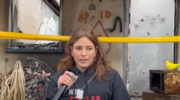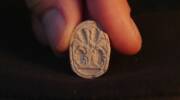The Land of Israel constantly reveals hidden treasures, testifying to its rich history. This time, archaeologists discovered an extraordinary 1,600-year-old shipwreck cargo off Israel’s coast dating from the Roman era.
A fortuitous discovery by two divers in the ancient port of Caesarea before the Passover holiday led to the exposure of a large, spectacular and beautiful ancient marine cargo of a merchant ship that sank during the Late Roman period 1,600 years ago.
This is the largest assemblage of marine artifacts to be recovered in Israel in the past thirty years.
A joint dive at the site together with Israel Antiquities Authorities (IAA) archaeologists revealed that an extensive portion of the seabed had been cleared of sand and the remains of a ship were left uncovered on the sea bottom: iron anchors, remains of wooden anchors and items that were used in the construction and running of the sailing vessel.
Many of the artifacts are bronze and in an extraordinary state of preservation: a bronze lamp depicting the image of the sun god Sol, a figurine of the moon goddess Luna, a lamp in the image of the head of an African slave, fragments of three life-size bronze cast statues, objects fashioned in the shape of animals such as a whale, a bronze faucet in the form of a wild boar with a swan on its head and other artifacts.
In addition, fragments of large jars were found that were used for carrying drinking water for the crew in the ship and for transportation at sea. One of the biggest surprises in particular was the discovery of two metallic lumps composed of thousands of coins weighing some 20 kilograms which was in the form of the pottery vessel in which they were transported.
This discovery comes a year after the exposure of a treasure of gold Fatimid coins by divers.
“These are extremely exciting finds, which apart from their extraordinary beauty, are of historical significance,” said Jacob Sharvit, director of the Marine Archaeology Unit of IAA. “The location and distribution of the ancient finds on the seabed indicate that a large merchant ship was carrying a cargo of metal slated for recycling, which apparently encountered a storm at the entrance to the harbor and drifted until it smashed into the seawall and the rocks.”
“A preliminary study of the iron anchors suggests there was an attempt to stop the drifting vessel before it reached shore by casting anchors into the sea; however, these broke – evidence of the power of the waves and the wind which the ship was caught up in”. Sharvit stresses.
“A marine assemblage such as this has not been found in Israel in the past thirty years. Metal statues are rare archaeological finds because they were always melted down and recycled in antiquity. When we find bronze artifacts it usually occurs at sea. Because these statues were wrecked together with the ship, they sank in the water and were thus ‘saved’ from the recycling process,” he added.
“In the many marine excavations that have been carried out in Caesarea only very small number of bronze statues have been found, whereas in the current cargo a wealth of spectacular statues were found that were in the city and were removed from it by way of sea. The sand protected the statues; consequently they are in an amazing state of preservation – as though they were cast yesterday rather than 1,600 years ago,” Sharvit said.
The coins that were discovered bear the image of the emperor Constantine who ruled the Western Roman Empire (312–324 CE) and was later known as Constantine the Great, ruler of the Roman Empire (324–337 CE), and of Licinius, an emperor who ruled the eastern part of the Roman Empire and was a rival of Constantine, until his downfall in a battle that was waged between the two rulers.
“In recent years we have witnessed many random discoveries in the harbor at Caesarea. These finds are the result of two major factors: a lack of sand on the seabed causing the exposure of ancient artifacts, and an increase in the number of divers at the site,” he explained.
The divers demonstrated good citizenship and are deserving of praise, the IAA stated. They will be awarded a certificate of appreciation and invited to tour the storerooms of the National Treasures.
“By reporting the discovery of the marine assemblage to the IAA they have made it possible for all of us to enjoy these spectacular remains from antiquity. The public should be aware that it must report any artifacts it finds immediately to the Marine Archaeology Unit of the Israel Antiquities Authority in order to maximize our archaeological knowledge about the site,” the IAA stated.
By: Max Gelber, United with Israel

Free Ebook: 10 Best Places to Visit in Israel
The Land of Israel has provided the backdrop for some of the most important events in human history. From the Old City in Jerusalem to the Sea of Galilee, people from all over the globe visit the Holy Land each year to take in the breathtaking scenery and inspiration of Israel. Now you can experience this beauty for yourself from the comforts of home and maybe plan a trip of your own to Israel. Get the free, exclusive eBook from United with Israel: The 10 Best Places to Visit in Israel.
Do You Love Israel? Make a Donation - Show Your Support!
Donate to vital charities that help protect Israeli citizens and inspire millions around the world to support Israel too!
Now more than ever, Israel needs your help to fight and win the war -- including on the battlefield of public opinion.
Antisemitism, anti-Israel bias and boycotts are out of control. Israel's enemies are inciting terror and violence against innocent Israelis and Jews around the world. Help us fight back!






















